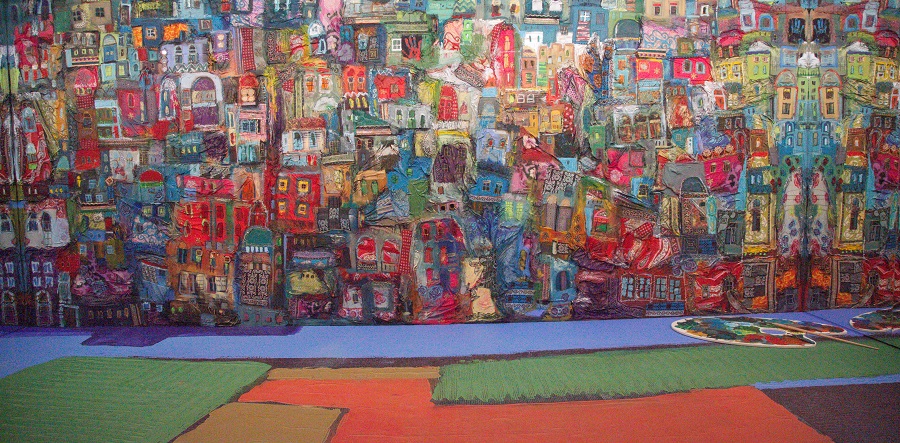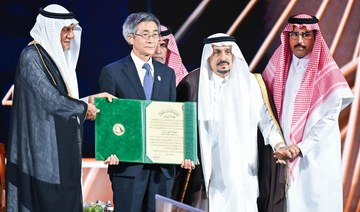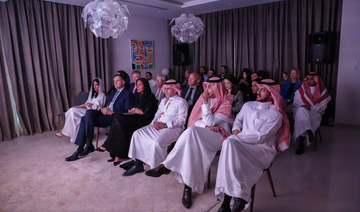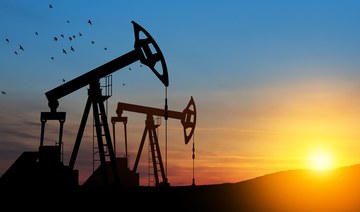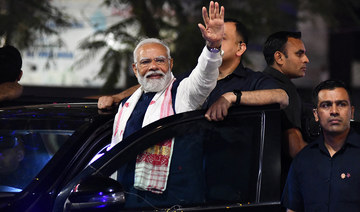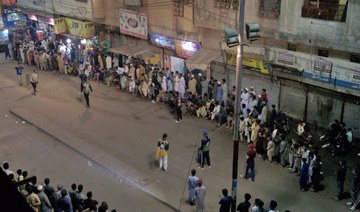LONDON: Russian oil major Rosneft will invest in gas pipelines in Iraq’s autonomous Kurdistan, expanding its commitment to the region ahead of an independence referendum to help it become a major exporter of gas to Turkey and Europe.
Kurdistan’s Parliament approved a plan on Friday to hold a referendum on independence on Sept. 25, ignoring opposition from Baghdad and the wider region as well as Western concerns that the vote could heighten tensions in the region.
Kurdistan has been exporting oil independently from Baghdad since 2014 and Kremlin-controlled Rosneft joined the list of buyers this year, lending the region hundreds of millions of dollars in loans guaranteed by future oil sales.
Now Rosneft is widening its investments to gas by agreeing to fund a natural gas pipeline in Kurdistan, Rosneft and the Kurdistan Regional Government (KRG) said on Monday. Two sources close to the deal said the investments would amount to more than $1 billion.
Erbil, the seat of the KRG in northern Iraq, needs money to fund the fight against Daesh and ease a budget crisis caused by low oil prices.
Kurdistan has relied on oil pre-finance deals to improve its fiscal position but has struggled to develop its large gas reserves.
For Rosneft, the world’s largest publicly listed oil company by production, the deal is a major boost to its international gas ambitions. Rosneft has long sought to challenge Gazprom, Russia’s gas export monopoly, in supplying gas to Europe.
For Turkey, it means the arrival of new supplies for its energy-hungry economy and the potential to become a major center for gas supplies to Europe.
The pipeline’s capacity is expected to handle up to 30 billion cubic meters (bcm) of gas exports a year, in addition to supplying domestic users. Kurdistan sits on some of the largest untapped gas deposits on Europe’s doorstep.
The volumes that Rosneft wants to help Kurdistan supply to export markets represent 6 percent of total European gas demand and one-sixth of current gas export volumes by Russia, by far the largest supplier of gas to Europe.
The pipeline will be constructed in 2019 for Kurdish domestic use, with exports due to begin in 2020.
“Successful implementation of the project ... will enable Rosneft to play a leading role in the building and expanding Kurdistan Region’s gas transport infrastructure and create synergy with existing projects for development of the oil and gas fields of the five blocks awarded to the company,” Rosneft said.
Rosneft secured a deal to develop five fields and has also agreed to help the region expand its oil pipeline infrastructure through which crude is exported via Turkey to global markets.
Kurdistan is seeking to boost oil exports to 1 million barrels per day (bpd) by the end of this decade from the current 0.65 million bpd.
The statement said Rosneft and the KRG had finished inspecting Kurdistan’s oil export pipelines and Rosneft would soon complete developing final documents for the expansion project.
Rosneft agreed to help Kurdistan expand the oil pipeline via so-called monetization, when investments are repaid via tariffs and oil flows.
Kurdish oil production has been mainly led in recent years by mid-sized firms such as Genel and DNO. Larger companies such as Exxon Mobil and Chevron are still at the exploratory stage.
Rosneft wins major Kurdistan gas deal
Rosneft wins major Kurdistan gas deal
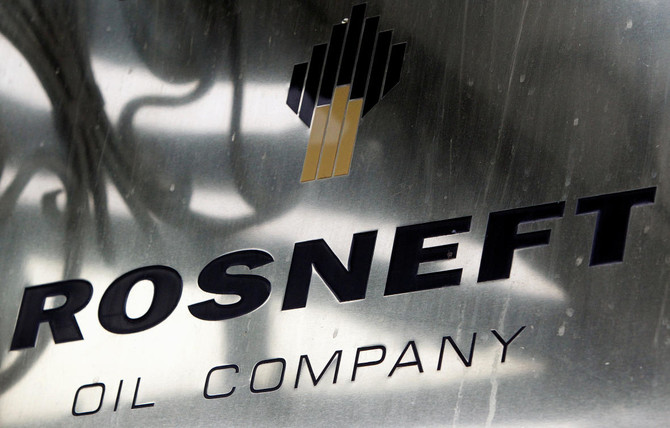
Saudi cultural attache in Japan receives Jeddah University delegation
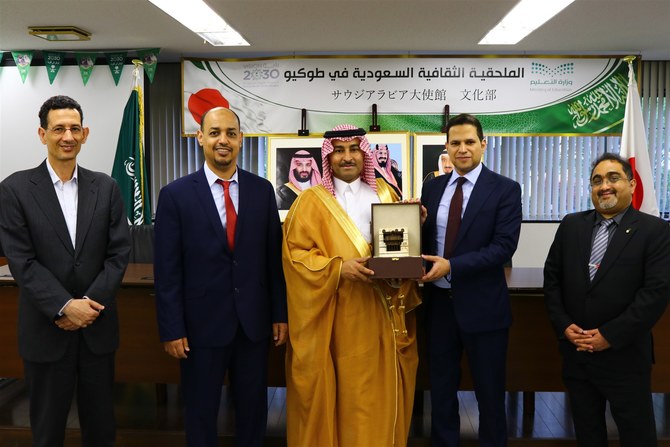
DUBAI: Saudi Arabia’s cultural attache in Japan hosted on Thursday a delegation from Jeddah University, led by the institution’s Vice President for Academic Affairs and Development Dr. Monagi bin Hassan Al-Kanaani.
Dr. Anas Ahmed, Jeddah University’s dean of the College of Engineering, and Dr. Mohammed Kalkatawi, director of the Data Management Office at the institution, were part of the delegation.
زار الملحقية الثقافية السعودية في #اليابان وفداً من #جامعة_جدة يرأسهم سعادة د. مناجي بن حسن الكناني وكيل الجامعة للشؤون الأكاديمية والتطوير ويرافقه سعادة د. أنس أحمد عميد كلية الهندسة و د. محمد كلكتاوي مدير مكتب إدارة البيانات بالجامعة خلال زيارتهم لليابان. pic.twitter.com/Cw72aLimXL
— الملحقية الثقافية السعودية في اليابان (@SaudiCultureJP) April 25, 2024
Badr Al-Otaibi, director of the office of the Saudi Arabia cultural attache in Japan, received the delegation.
The officials discussed their visits to several Japanese universities to explore cooperation opportunities and sign student-exchange agreements.
Oil Updates – crude steady as market weighs US demand concerns, Middle East conflict risks
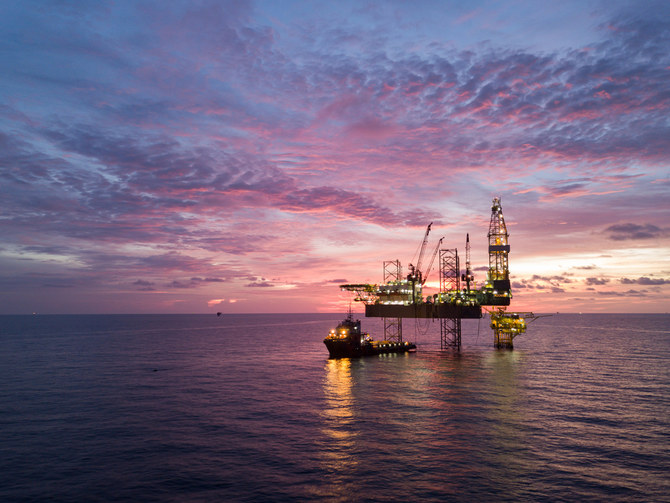
SINGAPORE: Oil prices steadied on Thursday after settling lower in the previous day, as signs of retreating fuel demand in the US, the world’s biggest oil user, contended with widening conflict risks in the key Middle East producing region, according to Reuters.
Brent crude futures inched up 18 cents, or 0.2 percent, to $88.20 a barrel at 9:30 a.m. Saudi time, while US West Texas Intermediate crude futures gained 13 cents, or 0.2 percent, to $82.94 a barrel.
Data from the US Energy Information Administration on Wednesday showed that gasoline stockpiles fell less than forecast while distillate stockpiles rose against expectations of a decline, reflecting signs of slowing demand.
The falling fuel demand is occurring amid signs of cooling US business activity in April and as stronger-than-expected inflation and employment data means the US Federal Reserve is more likely to delay expected interest rate cuts, weighing on economic sentiment.
“The current weakness in benchmark prices, after testing above $90 (a barrel) levels, is due to market sentiment refocusing on global economic headwinds over geopolitical tensions,” said Emril Jamil, senior oil analyst at LSEG Oil Research.
Geopolitics aside, prices this quarter will be driven by factors including major producer supply cuts, economic data out of China and Eurozone, on top of incremental demand expectations as the Northern Hemisphere heads into summer amid expected tighter supply, said Jamil.
A better indication of the Fed’s rate intentions will be seen after US gross domestic product and March personal consumption expenditure data is released on Thursday and Friday.
Meanwhile, fighting in the Gaza Strip between Israel and Hamas is expected to expand as Israel may start an assault on Rafah, in the enclave’s south, which may increase the risk of a wider war that could potentially disrupt oil supplies.
However, there have been no other signs of direct conflict between Israel and Hamas-backer Iran, a major oil producer, since last week.
“Tensions between Iran and Israel have eased, but Israeli attacks on Gaza are expected to worsen, and the risk of conflicts spreading to neighboring countries is underpinning oil prices,” said Toshitaka Tazawa, an analyst at Fujitomi Securities Co. Ltd.
Other EIA data on Wednesday showed that crude stocks slumped by 6.4 million barrels to 453.6 million barrels, compared with expectations in a Reuters poll for an 825,000-barrel rise.
Cricket facing its own climate test
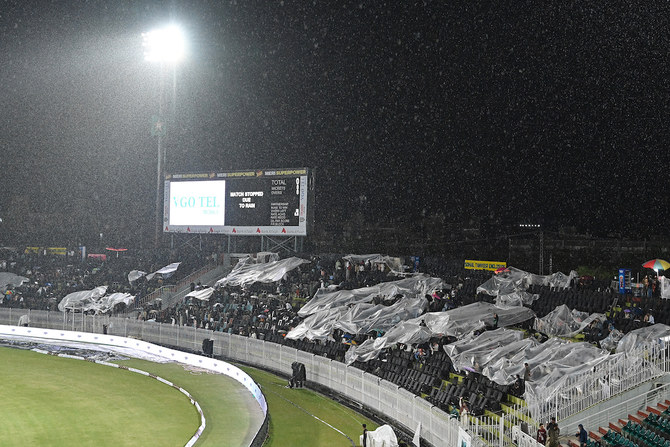
- With international cricket played throughout the year, the probability of matches being affected by adverse weather has increased
Rain is the scourge of cricket. It has the capacity to whip up conflicting feelings. Players may feel that it has rescued their team from looming defeat or denied them of certain victory.
Spectators may feel the same way but will not have the cover of a pavilion or dressing room in which to shelter. Furthermore, they are likely to feel deprived of part of their entrance fee. These feelings used to be commonly associated with cricket in the British Isles. This may still linger, given the wet start to the 2024 county cricket season, but it is no longer universally the case.
In the UAE, of all places, a year of rain is reported to have fallen in 24 hours, from late Monday to Tuesday. At 3 p.m. on Monday it was as dark as the night. Some reports suggested that cloud seeding was the cause, but why might that have been deployed at that time of year? The EU’s Copernicus Climate Change Service reports that the Earth recorded its hottest March on record, the 10th consecutive month to reach that feat. These all-time monthly highs were observed both in the air and in water. The Copernicus report judged that the temperatures were the result of decades of human-caused warming and El Nino climate patterns.
Obtaining a consensus on the causes seems beyond reach, although data points to an extraordinary surge in temperatures around the planet. This may stop once El Nino patterns end and temperatures cool. It is not yet possible to know if a fundamental shift has occurred in the Earth’s climate. In this uncertain moment, longer-term decisions have to be made by those responsible for running cricket.
An example of this is real in Worcester, England. Since 1896, Worcestershire County Cricket Club’s home has been at New Road, nestling under the watchful eye of the neighboring cathedral. This provides it with iconic status in the eyes of the cricketing world. The ground also sits on the west bank of the River Severn which, in recent years, has flooded with increasing regularity. This season, the county’s first two matches cannot be played there because the ground has not recovered from the winter’s flooding. Instead, they will be played at Kidderminster, 25km north.
The increased frequency and severity of flooding is causing the club’s management to assess alternative options to sustain its future. Amongst these are improved flood-alleviation measures and a move away from New Road, a prospect that is anathema to many supporters. The city is mindful of what happened to its soccer and rugby teams. The former moved grounds in 2013, resulting in a nomadic existence for a decade and a drop of three levels in the game’s pyramid. Its rugby team entered receivership in October 2022.
This sorrowful tale, thrown into stark perspective for Worcestershire CCC by adverse climate events, differs from the effects of adverse weather in other parts of the world. In the UAE, the effects were to cause the cancellation of a quadrangular tournament between the women’s T20 teams of the UAE, the US, the Netherlands and Scotland in Abu Dhabi. This was planned as a warm-up event before the ICC women’s T20I qualifying tournament in Abu Dhabi, set to open on April 25. Players have been deprived of valuable match practice, but that deprivation pales against that suffered by local residents.
During the Asia Premier Cup in Oman, there was rain, not of UAE proportions, but sufficient to disrupt some matches. The urbane curator of south Indian descent, Annop C Kandy, remarked that he had rarely seen rain in his eight years in charge and would normally expect temperatures in the 40°C range during April — an antidote to notions of a warming planet. He also revealed that whatever rain did fall came from the west and was short-lived. Unusually, this rain was from the south and southeast.
It caused much work for the curator and his staff, who coped admirably, notably when placing covers over the pitches during heavy windy conditions. Six of the 24 matches were shortened, two to 18 overs, two to 15 overs, one to 11 overs and one to eight overs. The last one affected Saudi Arabia and Nepal, with the latter winning with four balls to spare. It will never be known how the match would have played out if 20 overs had been possible.
Given that international cricket is now played around the world throughout the year, it should be no surprise that the probability of matches being affected by adverse weather has increased. It also seems that the severity of the impact is increasing. A recent example of this has occurred in Scotland. Unprecedented poor weather delayed pitch preparation at a ground near Dundee where a Cricket World Cup League 2 tournament between Scotland, Namibia and Oman was postponed. Originally due to take place between May 2 and 12, it is now scheduled for July, with the agreement of the three countries and the International Cricket Council.
It should not be forgotten that the 2023 Indian Premier League final was affected by rain in Ahmedabad. The match was originally scheduled to be played on May 28, but was postponed to the reserve day, May 29. This was the first time that the IPL final had been postponed because of adverse weather. Chennai Super Kings’ response was delayed for over an hour by rain and then the target adjusted with the innings being reduced to 15 overs. This outcome for a showpiece final was not ideal.
Although rain is regarded as cricket’s traditional bete noire, other climate issues have begun to be felt. During the ODI World Cup in India last November, extreme heat levels affected players, as did very high levels of air pollution, especially in Delhi. Cricketers and their administrators can do little to prevent the causes of these problems. What they are faced with is the need to devise and adopt measures which ameliorate the impact of climate issues and enhance the game’s sustainability. This may be about to get more difficult.
ADB highlights special focus on climate action, social equity in post-floods Pakistan
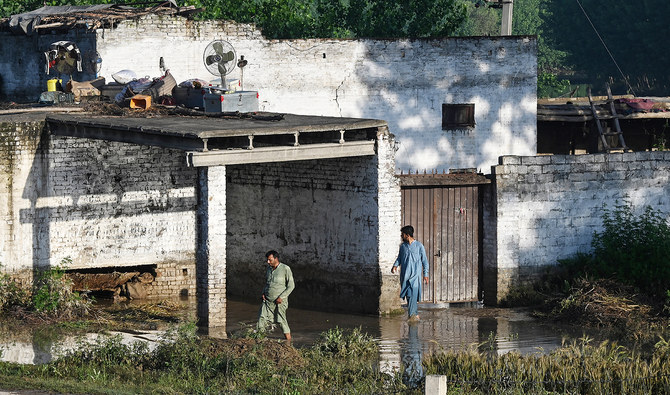
- The bank provided $180 million for climate-resilient, low-carbon municipal services in Punjab province last year
- It also worked to increase female inclusion in agriculture sector by helping them handle pesticides and fertilizers
KARACHI: The Asian Development Bank (ADB) announced on Thursday it deployed significant resources in Pakistan last year to aid the country’s economic recovery from the devastating 2022 floods, while supporting the government in other areas, including climate change, food security and gender parity, for sustainable and inclusive development.
The Philippines-based international financial institution began its operations in December 1966 and has since been promoting economic and social development in Asian and Pacific regions. Pakistan, one of its early members, has received ADB assistance over the years and developed many urban services and social sectors with its help.
In its Annual Report 2023, the ADB highlighted different areas in which it provided assistance to Pakistan during the last year.
“ADB signed a loan of $180 million to help develop climate-resilient and low-carbon municipal services for up to 1.5 million residents in the Punjab cities of Bahawalpur and Rawalpindi,” the report said.
“For Bahawalpur, the project includes a new recycling facility, a landfill with measures to mitigate greenhouse gas emissions and leachate, and new equipment and vehicles for citywide waste collection,” it continued. “For Rawalpindi, the project will, among other deliverables, construct a water treatment plant to process 54 million liters per day and implement distribution systems to serve around 82,000 households with metered connections.”
The report said the bank also signed an emergency grant of $5 million with the authorities in Islamabad to top up its flood assistance of $475 million from 2022.
“The grant supports farming households, including those headed by women, in the most flood-impacted area of Balochistan Province,” it informed. “It provides about 60,000 households with climate-resilient rice seeds sufficient to cultivate around 54,000 hectares, and includes measures to strengthen on-farm resilience to disasters triggered by natural hazards.”
The ADB also worked to improved agricultural productivity in the flood-affected Khyber Pakhtunkhwa province while trying to bolster the inclusion of women in by providing around 28,000 of them with training on seed cleaning and storage practices as well as on the safe handling of pesticides and fertilizers.
“ADB is also working to improve conditions for Pakistani women seeking to establish or expand their own businesses, particularly access to finance without the need for credit history or collateral,” the report added.
The bank also signed a $250 million loan for power transmission strengthening in the Khyber Pakhtunkhwa and Punjab provinces to help achieve environmental sustainability and climate resilience in the country’s power sector.
“The project aims to expand the national grid and enhance grid stability to improve energy access in the country, where only 80 percent of the population has access to electricity,” it said. “Upgrades under the project are expected to help supply 2 gigawatts of additional clean peak power and avoid about 13,700 tons of greenhouse gas emissions every year.”
ADB said it also provided a $300 million policy-based loan to the country for sustainable, broad-based and inclusive economic growth by strengthening the government’s capacity to generate domestic revenues to reduce budgetary constraints and restore macroeconomic stability.
“The program will help Pakistan improve tax administration and compliance, including through digitization,” the report said. “It will also enhance public expenditure and debt management, and increase trade and investment flows.”
Additionally, the bank committed $360 million under the Central Asia Regional Economic Cooperation (CAREC) program to help upgrade 330 kilometers of the national highway in Pakistan.
“This span of roadway links Pakistan’s hinterlands to CAREC Corridor 5, a vital trading route between landlocked Central Asian countries and the ports of Gwadar and Karachi,” it explained. “By enhancing the climate and disaster resilience of the highway, ADB is helping overcome high risks of road flooding and opening up a bottleneck to regional trade.”
The Arab world at the Venice Biennale: Artists explore themes of identity, immigration, history
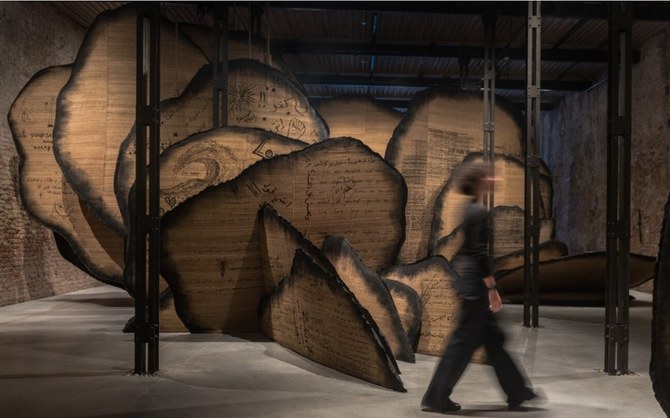
VENICE: No event in the international art scene is more anticipated, or debated, than the Venice Biennale. This year’s edition, “Foreigners Everywhere,” curated by Adriano Pedroso from Brazil, features 331 artists and 86 nations, including four Gulf countries as well as Lebanon and Egypt.
Saudi Arabia
Women’s voices chanting in unison fill the air of the Saudi Pavilion at Venice this year. “Shifting Sands: A Battle Song” was created by Saudi artist Manal AlDowayan, and hundreds of women from across the Kingdom participated in its creation. The exhibition, which includes large-scale installations in the form of desert roses filled with writing and drawings by the Saudi female participants whom AlDowayan worked with, aims to showcase the evolving role of women in the Kingdom while also striving to dispel media narratives that have long defined them. The chanting is derived from traditional battle songs once performed by Saudi men before they went into battle. Here they are chanted by women in a powerful chorus of strength and resilience, backed by recordings of the wind passing through sand dunes. The work, AlDowayan tells Arab News, “is about change, subtle changes — like those of a sand dune — the surface changes, but the core stays the same.”

UAE
Emirati artist Abdullah Al-Saadi is presenting “Sites of Memory, Sites of Amnesia” at the National Pavilion of the United Arab Emirates. It’s an introspective show consisting of drawings, sculptures, paintings and installations charting Al-Saadi’s travels around his homeland. “Traveling and understanding the natural world around me has always been an important part of my work,” Al-Saadi, who has even used rocks from the Emirates as his ‘canvas’ for some of the works, told Arab News. “Through this presentation in Venice, I hope visitors will enjoy tracing the travels I have taken over the past few years and also think about the world around us, and our place within it.”
Visitors will also be presented with gifts: maps and scrolls in colorful traditional chests from the region, which will be removed and presented to guests by actors from the UAE.
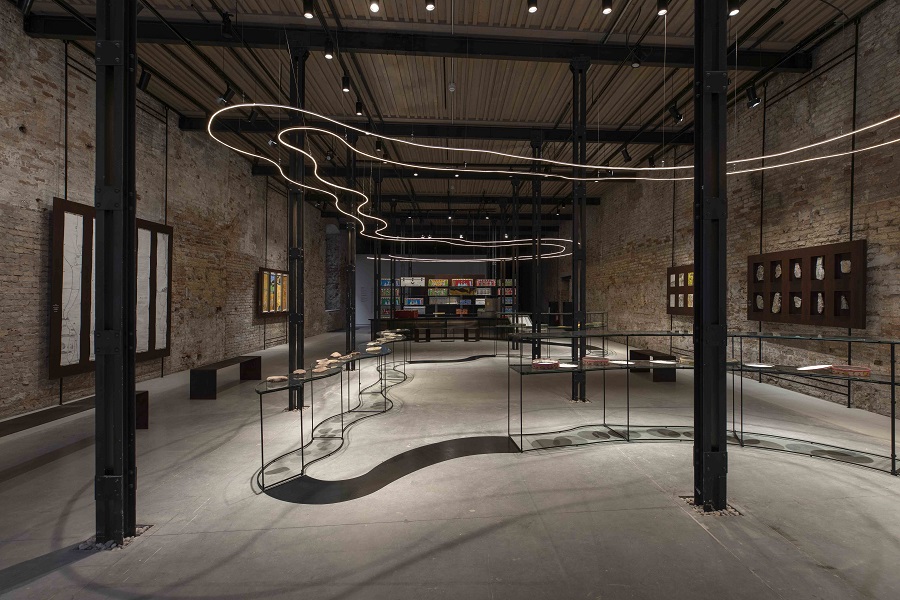
Qatar
While Qatar doesn’t have a national pavilion at the biennale, it is presenting “Your Ghosts Are Mine: Expanded Cinemas, Amplified Voices” — a group show of films by artists from across the Arab world, Africa and South Asia, as well as video installations from the collections of Mathaf: Arab Museum of Modern Art and the Art Mill Museum (scheduled to open in 2030). All the films were backed by the Doha Film Institute.
“For me, it was important to show movies reflective of the theme of the biennale — so, revolving around immigration, foreigners, personal diaries and self-portraits and stories from women — all coming from independent (artists) in the Global South, whose voices are not always shared,” the Paris-based curator Matthieu Orlean told Arab News.
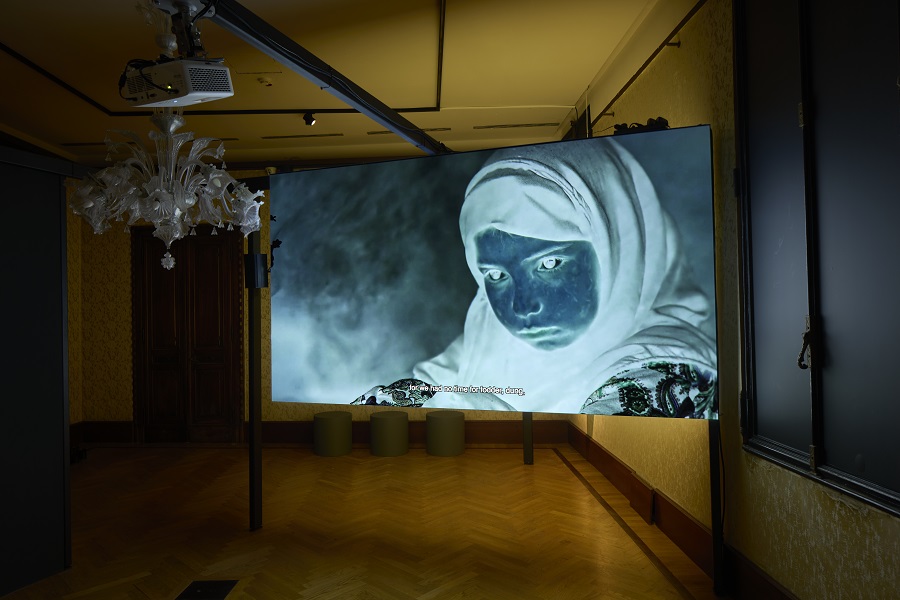
Egypt
Alexandrian-born artist Wael Shawky has created “Drama 1882,” a 45-minute film for which he also composed the music, for Egypt’s national pavilion, which — in the first week of the biennale at least — has proved to be one of the most popular pavilions at this year’s event.
The film is based around Egypt’s nationalist Urabi revolution against imperial influence in the late 19th century and Shawky uses historical and literary references as starting points from which to weave together a story that fuses fact, fiction and fable, while also exploring national, religious and artistic identity.
“I worked with performers who enacted a play in a theater for the film,” Shawky told Arab News. “The film strives in part to connect the idea of history to drama — drama regarding the connection to catastrophe and drama regarding cynicism. I like to analyze the authenticity of history, especially Egyptian history. When one makes films about history there is this gap between truth and myth.”

Lebanon
Lebanese artist Mounira Al-Solh’s multimedia installation “A Dance with Her Myth” combines drawing, painting, sculpture, embroidery, video, and audio, and guides viewers through ancient Phoenicia. The piece, Al-Solh explains to Arab News, is inspired by the tale of Europa, the daughter of a Phoenician king who was abducted from the city of Tyre in Lebanon by the Greek god Zeus, who had transformed himself into a white bull to trick her into riding him, then took her off into the sea.
“The (work) pays tribute to the ancient multicultural heritage of Lebanon,” Al-Solh says.
In the center of the pavilion is an unfinished boat, that Al-Solh says references “the tension that women still face today, despite their emancipation.”
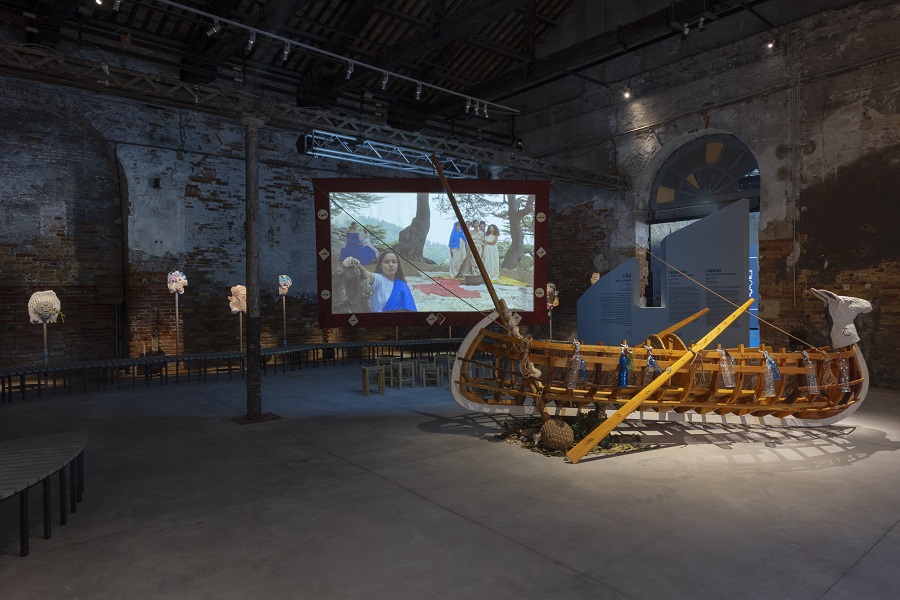
Oman
Oman’s second participation in the biennale, is an exhibition titled “Malath — Haven.” It includes work from five Omani contemporary artists: Ali Al-Jabri, Essa Al-Mufarji, Sarah Al-Aulaqi, Adham Al-Farsi and Alia Al-Farsi (who also curated the show). “We used the word ‘haven’ in the title because, since antiquity, foreigners — including the Romans, Portuguese and Indians — have visited Oman,” Alia Al-Farsi told Arab News. The works on display — from Al-Farsi’s own colorful and expressive mixed-media murals (such as “Alia’s Alleys,” pictured here) to Al-Aulaqi’s “Breaking Bread,” which includes a large sculpture of a niqab made from silver spoons — reflect both traditional and contemporary life in Oman.
“As an Omani creative with an international background, my aim was for the exhibition to serve as a sanctuary for visitors and travelers, allowing stories to unfold and intertwine, mirroring how our country finds its richness in intercultural dialogue,” the curator said in a statement.
